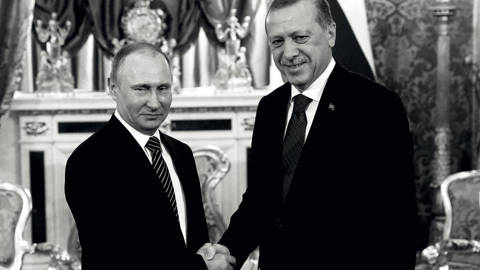CHICAGO – Since 2008, central banks in industrial countries have deviated from ordinary monetary policymaking in a variety of ways. They’ve tried to persuade the public through “forward guidance” that interest rates would stay low for extended periods of time. And they’ve deployed various programs such as long-term refinancing operations (LTROs), the Securities Markets Program (SMP), and quantitative easing (QE) in pursuit of various goals.
More recently, central banks have also introduced negative interest rates and – from the Bank of Japan (BOJ), which has always been at the forefront of innovation – yield-curve targeting. And some central banks have resorted to unconventional but well-known policies such as direct exchange-rate targeting.
But now, with most major central banks apparently seeking to normalize monetary policy, we should ask why these extraordinary measures were used and whether they worked. Looking forward, we should ask what effect phasing them out will have, and whether their use raises long-term concerns. By addressing these questions, central bankers will be better prepared to grapple with future crises.
Was It Necessary?
It is worth recalling that markets were clearly broken after the 2007-2008 financial crisis. With credit flows frozen, it was understandable that central banks would go to great lengths to stabilize financial markets, whether the mortgage-backed securities market in the US or the sovereign-bond market in Europe.
But a second reason for central banks to intervene was to affect yields or prices. This was a more adventurous objective, given that central banks typically manage prices only indirectly, by raising or lowering the policy interest rate, not through direct intervention. But when the policy rate reached the zero lower bound, central bankers deemed it necessary to affect prices on a variety of long-term securities, sometimes by targeting a particular class of security in the hope that the effect would spread across classes.
A third reason for central-bank intervention was to signal a commitment to preferred monetary policies. For example, if a central bank announced a program to purchase government securities, the implication was that it would not tighten monetary policy while the program was in effect. Regardless of the program’s stated intent, its corollary effect was to signal “low-for-long” interest rates.
Central banks have cited all of these justifications for pursuing occasionally aggressive – or innovative – monetary policies. But as an ex-central banker, I would include another reason, one that monetary authorities rarely mention: they are prisoners of their inflation-targeting mandate.
When central banks began setting a target band for inflation in the 1980s and 1990s, they were really focused on the upper limit. Few central bankers expected that the problem with inflation-targeting regimes would be the lower bound, and that they would be struggling to move inflation up into the band rather than down into it. They are now trapped by a mandate they do not necessarily know how to achieve.
The BOJ has been attempting to push inflation up for close to a decade and a half. During this time, many central bankers from around the world have been happy to tell BOJ officials, “It’s very easy. Here’s how you do it.” But when these same central bankers have found themselves facing low inflation, they have come to realize that things aren’t so simple.
One reason is that nobody really knows how to dislodge the public’s expectation of low inflation, which seems to fuel low inflation itself. Even the nuclear option of dropping “helicopter money” on the economy will fail if the people it lands on think the central bank piloting the mechanism is deranged. Fearing a future day of reckoning, people may simply stuff the cash into a mattress or into their savings accounts, instead of spending it.
In such an environment, central bankers really do have to worry that if they admit to having “no policy instruments left,” the public’s inflation expectations will collapse. Accordingly, they will always claim to have one more inflation-boosting bazooka up their sleeve, which they hope they will never have to bring out, let alone fire.
Though we have not seen a negative disinflationary spiral, which central bankers fear most, inflation has remained stubbornly low. Central bankers have thus constantly upped the ante on monetary innovation – that is, new instruments that might theoretically boost inflation – even though the ineffectiveness of their instruments has become increasingly apparent.
According to this logic, when QE has run its course, central banks must move to negative interest rates. And when negative interest rates prove insufficient, they must move to yield-curve targeting. At each stage, when a policy instrument proves increasingly ineffective, they have to roll out something new so that they aren’t seen as being complacent. Not providing an alternative would suggest that they have given up hope – and that everyone else should, too. That would virtually guarantee failure to achieve their mandate.
Did It Work?
This brings us to the second question: Did any of these innovative instruments work? In terms of stabilizing markets, yes, some policies seem to have been quite effective, either because a deep-pocketed player came in to buy securities, or because central banks put their weight behind markets and said, “We’re going to be here to make sure they function.” Spreads for periphery sovereign credit in Europe were widening rapidly until European Central Bank President Mario Draghi announced in July 2012 that the ECB would do “whatever it takes” to preserve the euro. That statement alone had a magical effect on markets.
But to the extent that these interventions were also intended to achieve inflation mandates, then, no, they have not worked – at least not yet. The United Kingdom has experienced a Brexit-induced currency depreciation and consequent inflation, which cannot really be credited to the Bank of England’s actions. The Fed is probably the closest to its target of about 2% PCE (personal consumption expenditure) inflation, but it is struggling to get there, despite a tight labor market. Other central banks remain wider of the mark.
Of course, central bankers would tell us that it’s only a matter of time before they hit their targets, and that their actions prevented a collapse of inflation expectations. Perhaps so. It’s possible that expectations haven’t spiraled downward in Japan and some other countries because central banks have repeatedly indicated that they are committed to their mandate and won’t give up. But it’s also possible that inflation has stabilized at a low level for other reasons.
Whether unconventional policies have had a direct effect on long-term interest rates (other than through signaling) also remains unclear. The evidence that they have is mixed. Some effects can be seen within a narrow timeframe and for a narrow class of instruments; but as soon as you expand your view, unconventional policies’ influence becomes much harder to discern. Or, to take one example, when the Fed buys US Treasury bonds, it has an effect on Treasuries. But it is much harder to make the case that it also has an effect on the entire spectrum of bonds. Complicating matters further, it is even more difficult to establish any link between unconventional policies and investment or consumption in the real economy.
In sum, central banks’ extraordinary policies have probably had a positive effect in terms of repairing markets and signaling long-term accommodative monetary policies. But their effect on real activity remains uncertain.
Safe to Let Go?
What happens when policies are reversed? The nice thing about expectations is they get front-loaded. We may have already seen what happens when a central bank changes signals: during the “taper tantrum” of 2013, a general sense that the Fed might terminate QE and start raising interest rates triggered market turmoil and quickly drove interest rates up.
Markets have since stabilized, but it remains to be seen if unconventional policies’ effects on financial-asset prices will be reversed when the policies are. As central banks start shrinking their balance sheets in 2018, longer-term bonds will be returned to the market, and the market’s holdings of excess reserves will be extinguished. Bond issuers will need to find more private buyers, but private buyers will have funds to buy more bonds. As this asset swap takes place, long-term interest rates can be expected to rise somewhat. And if markets are worried about the eventual stock they’ll have to absorb, the rise in interest rates could be rather abrupt.
Thus far, the Fed has advertised a measured pace of balance-sheet reduction, and the market seems to have taken this quite well. With much of the signaling behind us, one hopes that the bonds that are effectively dropped from the Fed balance sheet will be absorbed without sharp changes in bond prices, and only modest rises in long-term interest rates over time.
A more fundamental question is whether central banks should offload their balance sheets at all. Harvard University’s Jeremy C. Stein, Robin Greenwood, and Samuel G. Hanson contend that central banks should keep their balance sheets relatively large, because doing so creates safe, short-term instruments that the financial world lacks. When the private sector tries to meet the demand for short-term liabilities, they argue, it typically assumes too much risk, which then haunts the entire system.
But there are at least two reasons why central banks shouldn’t make big balance sheets permanent. For starters, to do so would be to take on liquidity management as a public service. The private sector’s inadequacy in performing this role during the financial crisis is not a good enough reason for central banks to perform it permanently. It is well known that publicly provisioned insurance-like services typically result in overreliance by the private sector and underpricing by the public sector. And, as my University of Chicago colleague Douglas Diamond and I have shown, privately provisioned liquidity services may have many additional benefits that are not always acknowledged in the public debate.
Moreover, large central-bank balance sheets introduce political risks. As Charles Plosser, a former president of the Federal Reserve Bank of Philadelphia, explains, when a central bank expands its balance sheet and uses it in ways that are not entirely tied to monetary policy, it exposes itself to political pressures.
For example, if the government needs, say, $500 billion for infrastructure spending, it will see little reason not to pressure the Fed to convert some of its holdings into infrastructure assets worth $500 billion. Central bankers in emerging markets are used to such requests. And while they usually politely refuse, they also understand that it is harder to say no when maintaining a large balance sheet that is already disconnected from conventional monetary policy.
Long-Term Risks?
Finally, there is the question of unconventional monetary policies’ long-term unintended effects on risk-taking in advanced economies, capital flows to and from emerging markets, and central-bank independence generally.
By prompting a search for yield, easy monetary conditions have reduced risk premia for all types of assets. But, as Claudio Borio and William White of the Bank for International Settlements have warned, this accelerates the financial cycle. Moreover, the promise of bountiful liquidity has increased leverage, both explicit and implicit, because borrowers, betting on continued access to funding, view taking on further debt as a low-cost endeavor. This suggests that the financial system is becoming more fragile, which helps to explain why some central banks are considering tightening monetary policy despite remaining far from their inflation targets.
One important example of how accommodative monetary policies contribute to financial fragility is their effect on emerging markets, where yield-seeking capital pours in when major central banks slash their policy rates, and then flees from those markets when monetary policies are tightened. The 2013 “taper tantrum” was calamitous for some emerging markets because they could not cope with the large, sudden capital outflows that it fueled.
A common analogy for foreign capital is that it is like a houseguest whom emerging markets should welcome. And, for the most part, they do. But foreign capital often comes en masse, and then departs en masse without much warning. Like any host, emerging markets would love to know when a huge crowd of guests expects to arrive, and when it intends to leave, so that they can plan accordingly. When capital bases its decision to come or go on what happens far away, it behaves like a very bad guest.
Cross-border bank flows are especially problematic. According to a recent study by Falk Bräuning of the Federal Reserve Bank of Boston and Victoria Ivashina of the Harvard Business School, when monetary policy tightens, cross-border bank flows quickly retreat from emerging markets, owing to the short maturity on bank loans. Unlike bonds sold by foreign holders, which can be picked up by domestic investors, a reduction in lending by foreign banks may not be offset. In the absence of additional lending by local banks, emerging-market companies often experience a credit squeeze.
So far, emerging markets have learned to muddle through episodes of substantial capital-flow reversal, at some cost to themselves. But there is an urgent debate to be had about the responsibility the world’s major central banks bear when these spillovers occur.
What Next?
One final question concerns the role of central banks’ domestic mandates in encouraging the kind of extraordinary policies we have seen in recent years. In the past, central banks have essentially said, “Give us a mandate, and don’t place constraints on how we achieve it.” But while this formula may have worked fine when the primary problem was high inflation – and when central banks’ primary instrument was the policy rate (and some marginal tweaks to liquidity) – it no longer works when the problem is low inflation.
Far-reaching operational freedom without a practical scientific understanding of how to achieve the mandate is a dangerous combination for central banks. They have come under intense pressure to innovate; and, at the same time, there are few assets they cannot buy, and even fewer borrowers they cannot fund.
When ostensible monetary policies increasingly have a fiscal component, central banks can end up in the business of anointing winners and punishing losers. It is then only a matter of time before politicians start asking why central banks have so much freedom. While doing whatever it takes to achieve their mandate, central banks may have inadvertently exposed themselves to closer political scrutiny and greater risks to their independence and power.
By doing so much to make up for political inaction at the start of the 2008 financial crisis, central bankers inserted themselves into the political limelight. They are heroes, certainly, for stepping in to mitigate the crisis. But politicians do not like powerful unelected heroes. With their PhDs, exclusive jargon, and secretive meetings in far-flung places like Basel and Jackson Hole, central bankers are the quintessential rootless global elite that populist nationalists love to hate. And that was true even before central banks started to tighten monetary policy.
Central bankers would of course prefer to avoid any discussion of their function and mandate. But, rather than waiting and hoping for the public spotlight to move somewhere else, they would be better off conducting a sober assessment of their policies over the last few years. It is incumbent upon monetary authorities to devise a mandate that is both reasonable and achievable, and to establish a set of actions that are permissible in achieving the mandate. Otherwise, 2018 will be just the beginning, rather than the end, of a brave new era for monetary policy.







CHICAGO – Since 2008, central banks in industrial countries have deviated from ordinary monetary policymaking in a variety of ways. They’ve tried to persuade the public through “forward guidance” that interest rates would stay low for extended periods of time. And they’ve deployed various programs such as long-term refinancing operations (LTROs), the Securities Markets Program (SMP), and quantitative easing (QE) in pursuit of various goals.
More recently, central banks have also introduced negative interest rates and – from the Bank of Japan (BOJ), which has always been at the forefront of innovation – yield-curve targeting. And some central banks have resorted to unconventional but well-known policies such as direct exchange-rate targeting.
But now, with most major central banks apparently seeking to normalize monetary policy, we should ask why these extraordinary measures were used and whether they worked. Looking forward, we should ask what effect phasing them out will have, and whether their use raises long-term concerns. By addressing these questions, central bankers will be better prepared to grapple with future crises.
Was It Necessary?
It is worth recalling that markets were clearly broken after the 2007-2008 financial crisis. With credit flows frozen, it was understandable that central banks would go to great lengths to stabilize financial markets, whether the mortgage-backed securities market in the US or the sovereign-bond market in Europe.
SPRING SALE: Save 40% on all new Digital or Digital Plus subscriptions
Subscribe now to gain greater access to Project Syndicate – including every commentary and our entire On Point suite of subscriber-exclusive content – starting at just $49.99.
Subscribe Now
But a second reason for central banks to intervene was to affect yields or prices. This was a more adventurous objective, given that central banks typically manage prices only indirectly, by raising or lowering the policy interest rate, not through direct intervention. But when the policy rate reached the zero lower bound, central bankers deemed it necessary to affect prices on a variety of long-term securities, sometimes by targeting a particular class of security in the hope that the effect would spread across classes.
A third reason for central-bank intervention was to signal a commitment to preferred monetary policies. For example, if a central bank announced a program to purchase government securities, the implication was that it would not tighten monetary policy while the program was in effect. Regardless of the program’s stated intent, its corollary effect was to signal “low-for-long” interest rates.
Central banks have cited all of these justifications for pursuing occasionally aggressive – or innovative – monetary policies. But as an ex-central banker, I would include another reason, one that monetary authorities rarely mention: they are prisoners of their inflation-targeting mandate.
When central banks began setting a target band for inflation in the 1980s and 1990s, they were really focused on the upper limit. Few central bankers expected that the problem with inflation-targeting regimes would be the lower bound, and that they would be struggling to move inflation up into the band rather than down into it. They are now trapped by a mandate they do not necessarily know how to achieve.
The BOJ has been attempting to push inflation up for close to a decade and a half. During this time, many central bankers from around the world have been happy to tell BOJ officials, “It’s very easy. Here’s how you do it.” But when these same central bankers have found themselves facing low inflation, they have come to realize that things aren’t so simple.
One reason is that nobody really knows how to dislodge the public’s expectation of low inflation, which seems to fuel low inflation itself. Even the nuclear option of dropping “helicopter money” on the economy will fail if the people it lands on think the central bank piloting the mechanism is deranged. Fearing a future day of reckoning, people may simply stuff the cash into a mattress or into their savings accounts, instead of spending it.
In such an environment, central bankers really do have to worry that if they admit to having “no policy instruments left,” the public’s inflation expectations will collapse. Accordingly, they will always claim to have one more inflation-boosting bazooka up their sleeve, which they hope they will never have to bring out, let alone fire.
Though we have not seen a negative disinflationary spiral, which central bankers fear most, inflation has remained stubbornly low. Central bankers have thus constantly upped the ante on monetary innovation – that is, new instruments that might theoretically boost inflation – even though the ineffectiveness of their instruments has become increasingly apparent.
According to this logic, when QE has run its course, central banks must move to negative interest rates. And when negative interest rates prove insufficient, they must move to yield-curve targeting. At each stage, when a policy instrument proves increasingly ineffective, they have to roll out something new so that they aren’t seen as being complacent. Not providing an alternative would suggest that they have given up hope – and that everyone else should, too. That would virtually guarantee failure to achieve their mandate.
Did It Work?
This brings us to the second question: Did any of these innovative instruments work? In terms of stabilizing markets, yes, some policies seem to have been quite effective, either because a deep-pocketed player came in to buy securities, or because central banks put their weight behind markets and said, “We’re going to be here to make sure they function.” Spreads for periphery sovereign credit in Europe were widening rapidly until European Central Bank President Mario Draghi announced in July 2012 that the ECB would do “whatever it takes” to preserve the euro. That statement alone had a magical effect on markets.
But to the extent that these interventions were also intended to achieve inflation mandates, then, no, they have not worked – at least not yet. The United Kingdom has experienced a Brexit-induced currency depreciation and consequent inflation, which cannot really be credited to the Bank of England’s actions. The Fed is probably the closest to its target of about 2% PCE (personal consumption expenditure) inflation, but it is struggling to get there, despite a tight labor market. Other central banks remain wider of the mark.
Of course, central bankers would tell us that it’s only a matter of time before they hit their targets, and that their actions prevented a collapse of inflation expectations. Perhaps so. It’s possible that expectations haven’t spiraled downward in Japan and some other countries because central banks have repeatedly indicated that they are committed to their mandate and won’t give up. But it’s also possible that inflation has stabilized at a low level for other reasons.
Whether unconventional policies have had a direct effect on long-term interest rates (other than through signaling) also remains unclear. The evidence that they have is mixed. Some effects can be seen within a narrow timeframe and for a narrow class of instruments; but as soon as you expand your view, unconventional policies’ influence becomes much harder to discern. Or, to take one example, when the Fed buys US Treasury bonds, it has an effect on Treasuries. But it is much harder to make the case that it also has an effect on the entire spectrum of bonds. Complicating matters further, it is even more difficult to establish any link between unconventional policies and investment or consumption in the real economy.
In sum, central banks’ extraordinary policies have probably had a positive effect in terms of repairing markets and signaling long-term accommodative monetary policies. But their effect on real activity remains uncertain.
Safe to Let Go?
What happens when policies are reversed? The nice thing about expectations is they get front-loaded. We may have already seen what happens when a central bank changes signals: during the “taper tantrum” of 2013, a general sense that the Fed might terminate QE and start raising interest rates triggered market turmoil and quickly drove interest rates up.
Markets have since stabilized, but it remains to be seen if unconventional policies’ effects on financial-asset prices will be reversed when the policies are. As central banks start shrinking their balance sheets in 2018, longer-term bonds will be returned to the market, and the market’s holdings of excess reserves will be extinguished. Bond issuers will need to find more private buyers, but private buyers will have funds to buy more bonds. As this asset swap takes place, long-term interest rates can be expected to rise somewhat. And if markets are worried about the eventual stock they’ll have to absorb, the rise in interest rates could be rather abrupt.
Thus far, the Fed has advertised a measured pace of balance-sheet reduction, and the market seems to have taken this quite well. With much of the signaling behind us, one hopes that the bonds that are effectively dropped from the Fed balance sheet will be absorbed without sharp changes in bond prices, and only modest rises in long-term interest rates over time.
A more fundamental question is whether central banks should offload their balance sheets at all. Harvard University’s Jeremy C. Stein, Robin Greenwood, and Samuel G. Hanson contend that central banks should keep their balance sheets relatively large, because doing so creates safe, short-term instruments that the financial world lacks. When the private sector tries to meet the demand for short-term liabilities, they argue, it typically assumes too much risk, which then haunts the entire system.
But there are at least two reasons why central banks shouldn’t make big balance sheets permanent. For starters, to do so would be to take on liquidity management as a public service. The private sector’s inadequacy in performing this role during the financial crisis is not a good enough reason for central banks to perform it permanently. It is well known that publicly provisioned insurance-like services typically result in overreliance by the private sector and underpricing by the public sector. And, as my University of Chicago colleague Douglas Diamond and I have shown, privately provisioned liquidity services may have many additional benefits that are not always acknowledged in the public debate.
Moreover, large central-bank balance sheets introduce political risks. As Charles Plosser, a former president of the Federal Reserve Bank of Philadelphia, explains, when a central bank expands its balance sheet and uses it in ways that are not entirely tied to monetary policy, it exposes itself to political pressures.
For example, if the government needs, say, $500 billion for infrastructure spending, it will see little reason not to pressure the Fed to convert some of its holdings into infrastructure assets worth $500 billion. Central bankers in emerging markets are used to such requests. And while they usually politely refuse, they also understand that it is harder to say no when maintaining a large balance sheet that is already disconnected from conventional monetary policy.
Long-Term Risks?
Finally, there is the question of unconventional monetary policies’ long-term unintended effects on risk-taking in advanced economies, capital flows to and from emerging markets, and central-bank independence generally.
By prompting a search for yield, easy monetary conditions have reduced risk premia for all types of assets. But, as Claudio Borio and William White of the Bank for International Settlements have warned, this accelerates the financial cycle. Moreover, the promise of bountiful liquidity has increased leverage, both explicit and implicit, because borrowers, betting on continued access to funding, view taking on further debt as a low-cost endeavor. This suggests that the financial system is becoming more fragile, which helps to explain why some central banks are considering tightening monetary policy despite remaining far from their inflation targets.
One important example of how accommodative monetary policies contribute to financial fragility is their effect on emerging markets, where yield-seeking capital pours in when major central banks slash their policy rates, and then flees from those markets when monetary policies are tightened. The 2013 “taper tantrum” was calamitous for some emerging markets because they could not cope with the large, sudden capital outflows that it fueled.
A common analogy for foreign capital is that it is like a houseguest whom emerging markets should welcome. And, for the most part, they do. But foreign capital often comes en masse, and then departs en masse without much warning. Like any host, emerging markets would love to know when a huge crowd of guests expects to arrive, and when it intends to leave, so that they can plan accordingly. When capital bases its decision to come or go on what happens far away, it behaves like a very bad guest.
Cross-border bank flows are especially problematic. According to a recent study by Falk Bräuning of the Federal Reserve Bank of Boston and Victoria Ivashina of the Harvard Business School, when monetary policy tightens, cross-border bank flows quickly retreat from emerging markets, owing to the short maturity on bank loans. Unlike bonds sold by foreign holders, which can be picked up by domestic investors, a reduction in lending by foreign banks may not be offset. In the absence of additional lending by local banks, emerging-market companies often experience a credit squeeze.
So far, emerging markets have learned to muddle through episodes of substantial capital-flow reversal, at some cost to themselves. But there is an urgent debate to be had about the responsibility the world’s major central banks bear when these spillovers occur.
What Next?
One final question concerns the role of central banks’ domestic mandates in encouraging the kind of extraordinary policies we have seen in recent years. In the past, central banks have essentially said, “Give us a mandate, and don’t place constraints on how we achieve it.” But while this formula may have worked fine when the primary problem was high inflation – and when central banks’ primary instrument was the policy rate (and some marginal tweaks to liquidity) – it no longer works when the problem is low inflation.
Far-reaching operational freedom without a practical scientific understanding of how to achieve the mandate is a dangerous combination for central banks. They have come under intense pressure to innovate; and, at the same time, there are few assets they cannot buy, and even fewer borrowers they cannot fund.
When ostensible monetary policies increasingly have a fiscal component, central banks can end up in the business of anointing winners and punishing losers. It is then only a matter of time before politicians start asking why central banks have so much freedom. While doing whatever it takes to achieve their mandate, central banks may have inadvertently exposed themselves to closer political scrutiny and greater risks to their independence and power.
By doing so much to make up for political inaction at the start of the 2008 financial crisis, central bankers inserted themselves into the political limelight. They are heroes, certainly, for stepping in to mitigate the crisis. But politicians do not like powerful unelected heroes. With their PhDs, exclusive jargon, and secretive meetings in far-flung places like Basel and Jackson Hole, central bankers are the quintessential rootless global elite that populist nationalists love to hate. And that was true even before central banks started to tighten monetary policy.
Central bankers would of course prefer to avoid any discussion of their function and mandate. But, rather than waiting and hoping for the public spotlight to move somewhere else, they would be better off conducting a sober assessment of their policies over the last few years. It is incumbent upon monetary authorities to devise a mandate that is both reasonable and achievable, and to establish a set of actions that are permissible in achieving the mandate. Otherwise, 2018 will be just the beginning, rather than the end, of a brave new era for monetary policy.